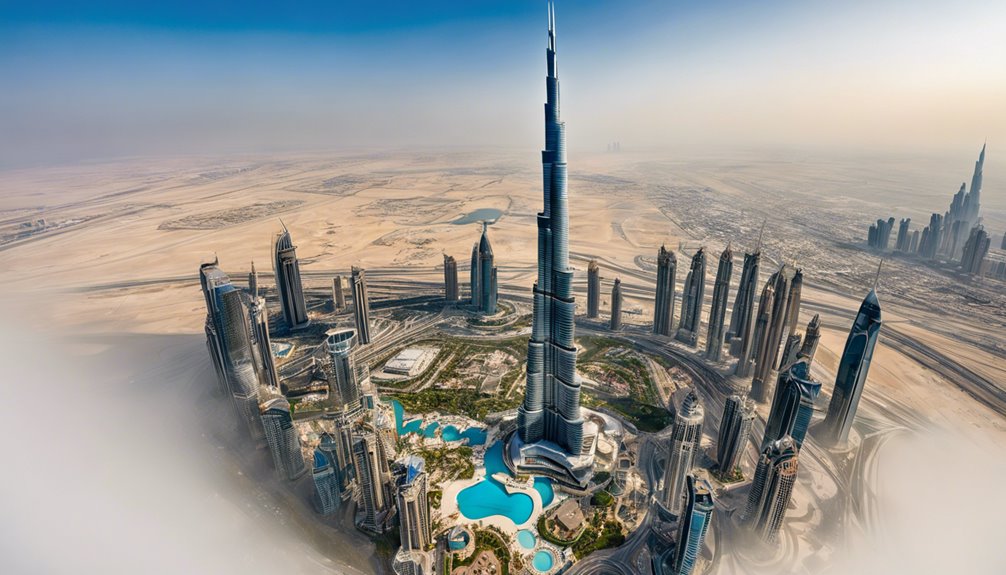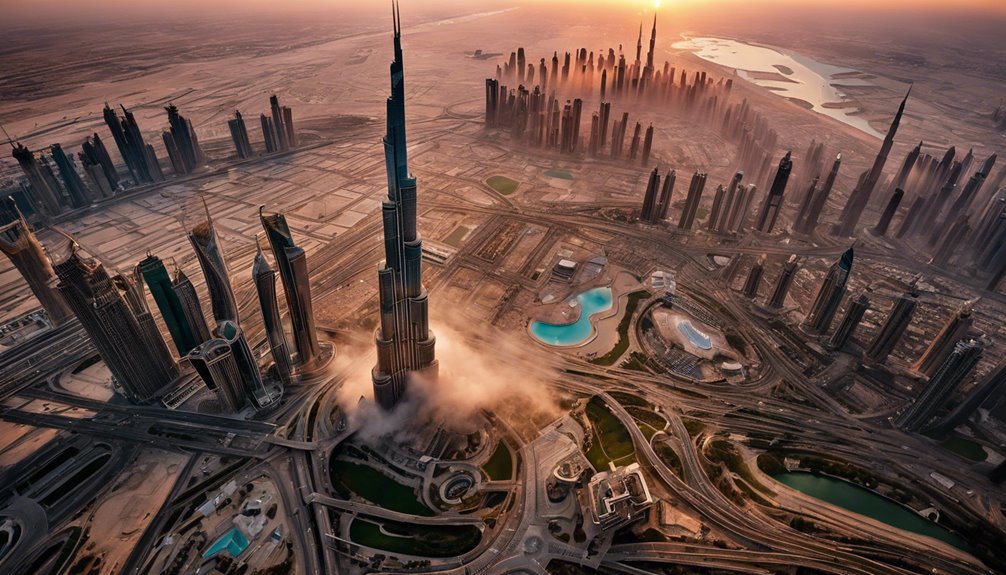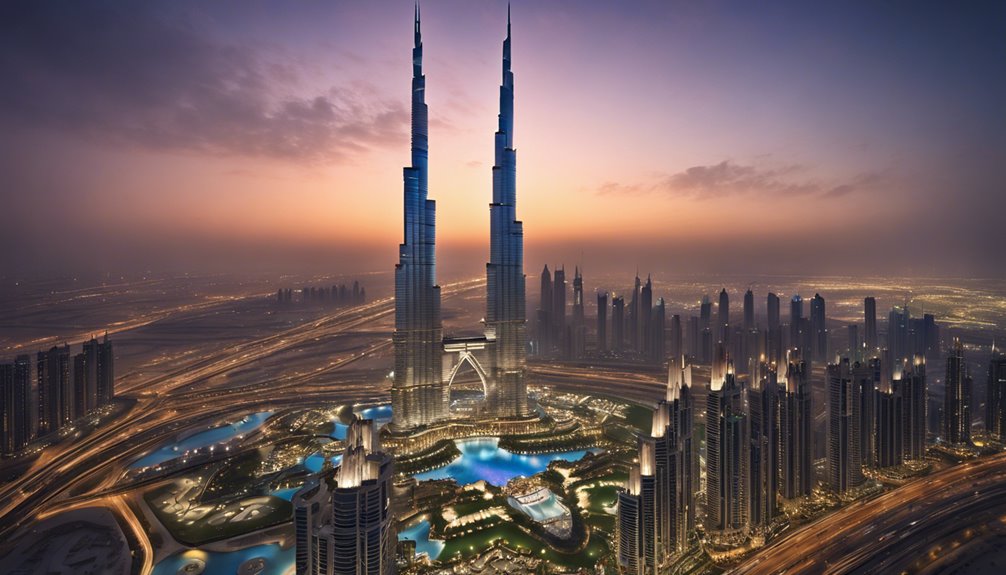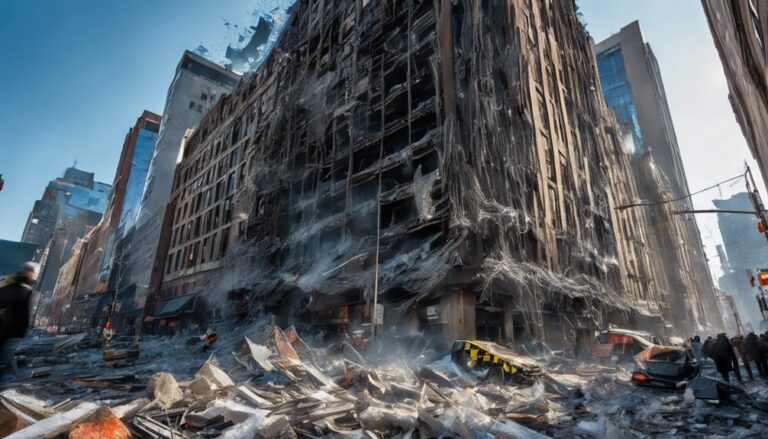The Burj Khalifa in Dubai impressively boasts a total of 163 floors above ground, making it the tallest structure in the world. This architectural feat showcases advanced engineering and design, embodying Dubai's modernity. Each floor serves a purpose, with retail spaces below, residential apartments in the middle, and corporate offices higher up. You'll find observation decks on the 124th and 148th floors, offering breathtaking views of the city. This mix of function and luxury not only redefines urban living but also attracts millions of tourists. If you're curious about its impact and unique features, there's much more to explore.
Overview of Burj Khalifa

The Burj Khalifa stands as a towering symbol of architectural ingenuity and ambition in Dubai. Completed in 2010, its history is a reflection of the city's drive for innovation and luxury. Rising 828 meters, it not only redefined the concept of skyscrapers but also transformed Dubai's iconic skyline, making it instantly recognizable worldwide. The design, inspired by Islamic architecture, features a triple-lobed footprint, reflecting nature and culture, which invites awe from visitors. Its construction involved cutting-edge technology and materials, reflecting a commitment to excellence. As you gaze at this marvel, you can't help but feel a sense of freedom, inspired by the heights of human creativity. The Burj Khalifa remains an enduring symbol of what's possible when ambition meets vision.
Total Number of Floors
When you look at the Burj Khalifa, you can't help but notice its impressive architectural design features, which contribute to its status as the tallest building in the world. With a total of 163 floors, it not only surpasses other skyscrapers but also offers various visitor access levels that enhance the experience. Understanding these elements gives you a clearer picture of why this iconic structure stands out globally.
Architectural Design Features
Although the Burj Khalifa stands as a tribute to modern engineering, its architectural design is equally impressive, particularly when considering its staggering total of 163 floors. This iconic skyscraper showcases sustainable design principles through its energy-efficient systems and water-conserving features. You'll notice the innovative materials used in its construction, like reinforced concrete and reflective glass, which not only enhance durability but also minimize environmental impact. The building's unique Y-shaped footprint contributes to its stability while maximizing views of the surrounding landscape. As you explore its soaring height, you'll appreciate how each floor is meticulously crafted to balance aesthetics with functionality, embodying a vision of freedom and progress that resonates deeply within urban architecture.
Height Comparison Worldwide
With an impressive total of 163 floors, the Burj Khalifa not only dominates the Dubai skyline but also ranks as one of the tallest buildings in the world. When you investigate height statistics, you'll notice that few global skyscrapers come close to this architectural marvel. For instance, the Shanghai Tower has 128 floors, and the Abraj Al Bait in Mecca boasts 120. These comparisons highlight the Burj Khalifa's extraordinary height, creating a sense of freedom in reaching for the skies. The sheer scale of the Burj Khalifa invites admiration and inspires future innovations in skyscraper design. As you explore these towering structures, you'll appreciate the engineering feats that allow humanity to defy gravity and redefine urban landscapes.
Visitor Access Levels
What makes the Burj Khalifa a must-visit destination for tourists is not just its height but also the accessibility of its floors. With 163 floors, you'll find that visitor access is primarily granted to the 124th and 148th floors, offering breathtaking views of Dubai. To guarantee a smooth experience, it's important to follow the visitor guidelines, which streamline your journey up this iconic structure. Ticket pricing varies based on the floor you choose, providing options for every budget. For the 148th floor, you'll pay a premium, but the unique perspective is often worth it. By planning ahead and understanding these elements, you can fully embrace the freedom of exploration within this architectural marvel.
Distribution of Floors

When you consider the Burj Khalifa's impressive total of 163 floors, each level serves a specific purpose that enhances its functionality. You'll find residential areas, corporate offices, and hospitality spaces carefully distributed throughout the tower, maximizing the use of vertical space. Significantly, the observation deck is strategically located on the 148th floor, offering breathtaking views that attract countless visitors.
Total Floor Count
The Burj Khalifa boasts an impressive total of 163 floors, each serving distinct purposes that contribute to the building's iconic status. The distribution of floors showcases a blend of luxury and functionality, making it a marvel of modern architecture.
- Residential units provide breathtaking views.
- Corporate offices drive economic activity.
- Observation decks offer a unique experience.
- Hotel suites deliver unparalleled comfort.
- Amenities enhance the living experience.
The choice of floor materials plays a crucial role in aesthetics and durability, while efficient floor maintenance guarantees the structure remains pristine. This meticulous attention to detail not only reflects the building's grandeur but also caters to the freedom and aspirations of those who inhabit or visit this extraordinary landmark.
Designated Use Areas
With 163 floors, the Burj Khalifa is meticulously designed to accommodate a variety of functions, ensuring that each area serves its intended purpose effectively. The distribution of floors is a brilliant showcase of design functionality and use efficiency. In the lower levels, you'll find retail spaces and hotels, catering to both tourists and locals. As you ascend, residential apartments occupy the middle floors, offering stunning views and luxurious living. The upper levels are dedicated to corporate offices, creating a hub of business activity. This careful allocation not only maximizes space but also enhances the experience for occupants and visitors alike. Each designated use area contributes to the overall harmony of the building, making it a symbol of contemporary architectural prowess.
Observation Deck Location
Although many visitors flock to the Burj Khalifa for its breathtaking views, the location of its observation decks is strategically chosen to promote the overall experience. The building features two main viewing platforms that offer unique perspectives of Dubai's skyline.
- The first observation deck is on the 124th floor, providing an accessible experience with stunning panoramic views.
- The second deck, located on the 148th floor, elevates your observation experience, granting you unparalleled vistas.
- Both platforms are designed for comfort and enjoyment, encouraging you to linger.
- You'll find interactive displays, enhancing your understanding of the city.
- The architectural design aligns with the surrounding landscape, creating a harmonious viewing environment.
These thoughtful placements guarantee your visit is both memorable and exhilarating.
Unique Features of Each Floor
Burj Khalifa boasts 163 floors, each offering distinct features that contribute to its iconic status. From luxurious residential spaces to high-end commercial areas, the building showcases unique architecture that marries modernity with cultural elements. You'll discover floor amenities tailored to enhance comfort and convenience; on some levels, lush gardens provide a serene escape, while others feature state-of-the-art fitness centers. The observation decks, positioned strategically, offer breathtaking views that redefine skyline experiences. Each floor's design reflects the vision of its creators, blending functionality with aesthetic appeal. As you explore, you'll appreciate how these elements work harmoniously, making every level a celebration of innovation and freedom, inviting you to experience life at new heights.
Residential vs. Commercial Spaces

The Burj Khalifa's remarkable design not only captivates the eye but also serves distinct purposes across its many floors. With a blend of luxury living and commercial offices, this skyscraper offers a unique urban experience. You'll find:
- Spacious residential apartments with breathtaking views
- High-end amenities for a lavish lifestyle
- Commercial offices that cater to global businesses
- Stylish lounges and meeting spaces for professionals
- A vibrant community atmosphere
This carefully curated mix enhances the building's allure, making it a sought-after destination for both residents and companies. The balance of residential comfort and commercial functionality allows you to embrace freedom in your living and working environments, truly embodying the essence of modern city life.
Observation Decks and Viewing Areas
When you step into the Burj Khalifa, you're not just visiting a building; you're experiencing some of the most breathtaking views in the world. The observation decks, located on the 124th and 148th floors, offer unparalleled observation experiences that will leave you in awe. From these heights, you can gaze across the Dubai skyline, the desert, and the shimmering coastline. These platforms are designed for ideal view photography, allowing you to capture stunning images of the city below. The combination of glass walls and open-air terraces enhances your connection with the surroundings. Whether you're capturing memories or simply soaking in the atmosphere, the Burj Khalifa's observation areas provide a sense of freedom and exhilaration that's hard to match.
Significance of the Burj Khalifa
Standing as a symbol of architectural innovation and ambition, the Burj Khalifa represents more than just a skyscraper; it embodies the spirit of modern Dubai. Its significance extends beyond its towering height, influencing both the cultural and economic landscapes of the region.
- Attracts millions of tourists annually.
- Serves as a hub for business and commerce.
- Inspires local and international architectural endeavors.
- Represents the United Arab Emirates' rapid development.
- Fosters a sense of national pride and identity.
The Burj Khalifa's cultural impact resonates through its iconic silhouette, while its economic significance drives investments, creating job opportunities and stimulating growth. Fundamentally, it's a beacon of progress, showcasing what's possible when vision meets execution.
Frequently Asked Questions
How Tall Is the Burj Khalifa in Meters and Feet?
When you think of the Burj Khalifa, you're really contemplating a marvel of modern architecture. Standing at a staggering height of 828 meters, or 2,717 feet, this iconic structure isn't just tall; it's a symbol of human ingenuity and ambition. Its architectural significance lies in how it pushes the boundaries of design and engineering, inspiring freedom in thought and creativity. You can't help but be awed by its stature and elegance.
Who Designed the Burj Khalifa?
You might be curious about who designed the Burj Khalifa. The architectural inspiration came from traditional Islamic architecture and the Hymenocallis flower. The design process, led by Adrian Smith at Skidmore, Owings & Merrill, involved innovative engineering and sustainability considerations. This collaboration resulted in a towering structure that symbolizes not just luxury, but freedom in architectural expression. The Burj Khalifa stands as a monument to modern design principles intertwining with cultural heritage.
How Long Did It Take to Construct the Burj Khalifa?
When you look at the Burj Khalifa, it's fascinating to think about the project timeline. It took about six years to construct, from 2004 to 2010. During that time, the team faced numerous construction challenges, including extreme weather and logistical issues. Yet, their determination and innovative solutions allowed them to overcome these obstacles, ultimately leading to the completion of this architectural marvel that redefined the skyline and inspired future projects.
What Is the Total Height of the Burj Khalifa Including Its Antenna?
When considering the Burj Khalifa height, you should note that the building stands at an impressive 828 meters, including its antenna. This antenna isn't just a design element; it plays a significant role in telecommunications, enhancing connectivity throughout the region. The integration of the antenna with the overall structure exemplifies modern engineering, pushing boundaries and redefining what skyscrapers can achieve. It symbolizes innovation, reflecting a commitment to progress and connectivity in urban environments.
Are There Any Hotels Inside the Burj Khalifa?
Imagine waking up amidst the clouds—sounds enticing, right? Yes, there are luxury accommodations within the Burj Khalifa. The Armani Hotel, designed by fashion icon Giorgio Armani, offers a unique blend of elegance and comfort. Guests enjoy exceptional Burj experiences, from private dining to exclusive spa treatments. Staying here isn't just about the amenities; it's about immersing yourself in a world of opulence and breathtaking views that few can claim to have experienced.




